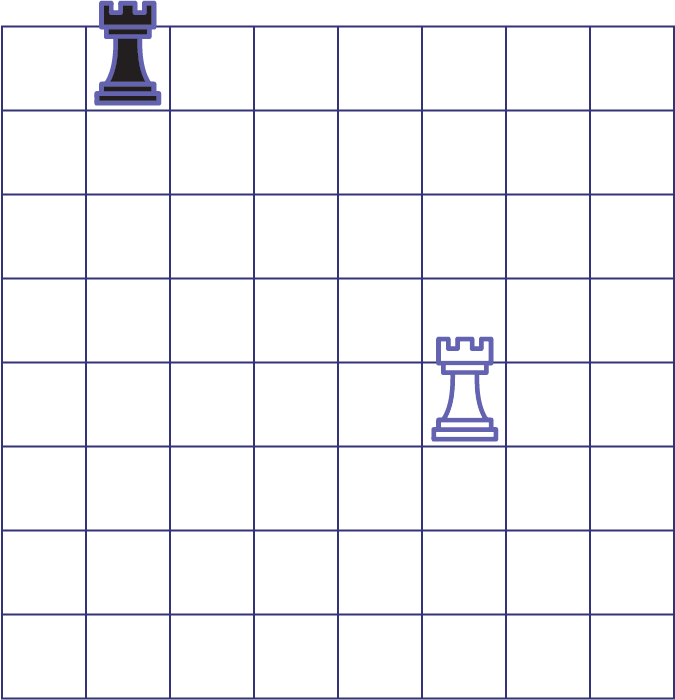E1.5 Describe the relative positions of several objects and the movements needed to get from one object to another.
Activity 1: Snakes and Ladders Game (Vocabulary Associated with Movement)
Instructions
Form teams of two students.
Give each team a snakes and ladders game.
Explain the rules of the game. After each round, ask students to describe the movement of their piece on the game board.
Allow students the time necessary to play a game.
Teacher Moves
Circulate among students and ask questions such as:
- Can you describe the movement of your game piece?
- In which direction did you move your piece?
When all teams have finished, ask questions such as:
- What happens when your piece reaches the bottom of a ladder?
- What happens when your piece reaches the head of a snake?
- In what direction will your piece move if you roll a three at the starting point?
Source: translated from Guide d'enseignement efficace des mathématiques, de la 1re à la 3e année, Géométrie et sens de l'espace, p. 68.
Activity 2: One, Two, Three … I Guess
Instructions
Form teams of two students.
Play guessing games with a Hundreds Chart.
Sample Questions
- I am between 25 and 27. What am I?
- I am in the box above 78. What am I?
Ask students to create their own riddles using all the phrases they have studied to describe the position.
Source: translated from Guide d’enseignement efficace des mathématiques de la 1re à la 3e année, Géométrie et sens de l'espace, p. 110.
Activity 3: Three in a Row Game
Materials
- Appendix 2I.3
- pattern blocks (squares and triangles)
- masking tape
Instructions
Expand Appendix 2I.3 so that the squares and triangles in a pattern blocks set can fit in the cells on the grid.
Using masking tape, label 12 squares and 12 triangles from 1 to 12.
Project the enlarged Appendix 2I.3.
Divide the class into two teams: the orange square team and the green triangle team.
Explain the rules of the game to students:
- The team with the green triangles starts.
- One member of this team must place triangle 1 on one of the cells in the last row of the grid and must describe the position of their triangle to the other team.
- One member of the orange square team then places square 1 next to or above triangle 1 and describes the position of square 1 in relation to triangle 1.
- Squares or triangles should be placed immediately next to or above another shape.
- The first team to create a vertical or horizontal sequence of three squares or three triangles wins the game.
Example of a Game
1st team: I place triangle 1 in the 3rd box of the last row.
2nd team: I place square 1 in the box immediately to the right of triangle 1.
1st team: I place triangle 2 immediately above triangle 1.
2nd team: I place square 2 immediately above triangle 2.
1st team: I place triangle 3 immediately to the left of triangle 1.
2nd team: I place square 3 immediately to the left of triangle 3.
1st team: I place triangle 4 immediately above triangle 3.
2nd team: I place square 4 immediately above square 1.
1st team: I place the triangle 5 immediately above the square 3 and win the game, because the triangles 5, 4 and 2 form a sequence of 3.

Source: translated from Guide d’enseignement efficace des mathématiques de la 1re à la 3e année, Géométrie et sens de l'espace, p. 108-109.
Activity 4: Checkmate
Instructions
Form teams of two students.
Provide each team with a checkerboard or a copy of Appendix 2PD.1.
Give each student a different coloured game piece (for example, a black tower and a white tower made with cubes).
Example
Each student places their tower on a different square.

Explain the game:
- the black tower moves to the right, to the left, up or down;
- the white tower represents the starting tower and the black tower, the finishing tower;
- the goal is to find as many paths as possible to get from one tower to another.
Note: Leave several copies of Appendix 2PD.1 available for students.
Source: translated from Guide d’enseignement efficace des mathématiques de la 1re à la 3e année, Géométrie et sens de l'espace, p. 132.
